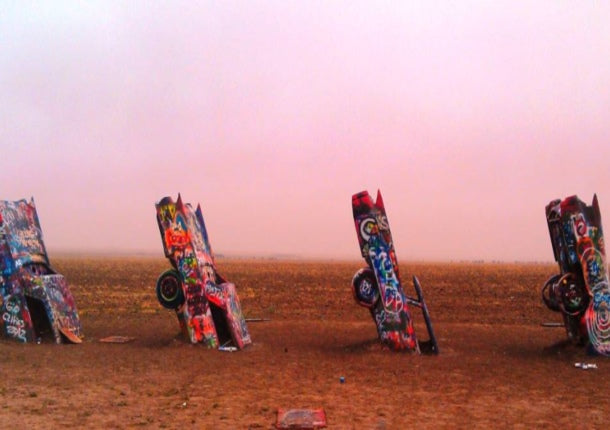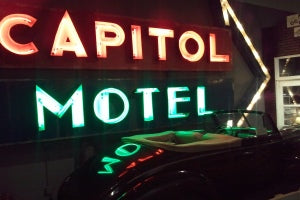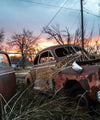Recent Post
Route 66 | Day 1
Aug 29, 2023

Andy Wegener
Mar 15, 2023
Why Just Drive By When You Can Spray Paint a Cadillac?
Imagine cruising along Route 66, the sun casting a golden hue over the asphalt, while your favorite tunes form the perfect backdrop to a picture of freedom. As you ride the iconic highway, the Texas skyline unfurls before you like a canvas waiting to be painted. Suddenly, in the distance, you spot an unusual spectacle: ten Cadillacs, nose-down, tail fins pointing skyward, and adorned in a riot of psychedelic graffiti. This is the Cadillac Ranch - an idiosyncratic celebration of cars, art, and American roadside eccentricity. So, what's the captivating story behind this legendary attraction? It's time to buckle up and delve into a narrative as vibrant and colorful as the Cadillacs themselves.

The Brainchild of Eccentrics: Stanley Marsh 3 Meets The Ant Farm
Stanley Marsh 3 was far from being a conventional Texas millionaire. Rejecting the formality of Roman numerals, he opted for "3" instead of "III," finding the latter ostentatious. Marsh's penchant for the unconventional naturally drew him towards The Ant Farm, an avant-garde art collective based in San Francisco. This meeting of eclectic minds gave birth to a whimsical concept: why not partially bury ten Cadillacs in a wheat field in a dramatic display of artistic expression?
Tail Fins in the Ground: The Building of a Legacy
The Cadillacs, meticulously selected to showcase the brand's evolution from 1949 to 1963, were half-buried nose-first at an angle akin to the Great Pyramid of Giza. Installed in 1974, the spectacle was initially met with skepticism by locals. Yet, true to its essence, the art invoked a range of emotions and responses. Was it a commentary, a curiosity, or simply an indulgence of eccentricity? Regardless, art is meant to stir emotions, and the Cadillac Ranch succeeded in doing just that.

Make Your Mark: An Invitation to Vandalism (The Good Kind)
With time, the Cadillac Ranch evolved into what some affectionately term the "Mona Lisa of the Panhandle." Unlike conventional art pieces, however, visitors were invited to leave their unique mark on these metallic canvases. Armed with spray paint cans, people from all walks of life adorned the cars with messages of love, proposals, baby gender reveals, and sometimes, even bittersweet break-up notes.
Moving Day: A Ranch on the Run
In 1997, faced with encroaching urban sprawl, the Ranch was relocated two miles west of its original location. Yet, its magnetic charm remained undeterred. Enthusiasts and new fans alike followed, spray cans in tow, eager to leave their mark on this living piece of art.

Deeper Than Paint: Cultural Significance
At first glance, the Cadillac Ranch may seem like an eccentric playground, but it stands as a deeper commentary on American culture. The half-buried, continuously evolving Cadillacs are metaphoric representations of the American Dream - compelling, yet elusive. Each layer of paint contributes to a multifaceted tapestry that encapsulates diverse narratives and shared experiences.
From Springsteen to Selfies: Impact on Popular Culture
The Ranch has wielded influence far beyond its physical location. Bruce Springsteen immortalized it in a song, numerous documentaries and films have showcased it, and countless Instagram selfies bear the tag #CadillacRanch. The site has also inspired similar installations (see epilogue), underscoring its cultural impact. To truly claim having experienced Route 66, one must interact with the vibrant energy of the Ranch.

More Than Just Cars in the Ground
Standing there, spray can in hand, one realizes that the Cadillac Ranch is not just a collection of junked cars. It's a confluence of history, culture, and art, manifesting as a technicolor spectacle against the Texas skyline. These cars, emerging from the earth in defiant angles, tell a story of evolution—both of the automobile industry and of society's shifting ideals and aesthetics.
A Canvas of Continuous Evolution
Every individual who adds a splash of color to the Cadillacs becomes a part of an ongoing narrative. The cars, despite being static, are in a state of perpetual change. The paint layers thicken, messages are obscured by new ones, and the Cadillacs continue their silent observation of the world around them. It's a testament to the transient yet enduring nature of art and expression.

A Magnet for Creativity and Community
Over the decades, the Cadillac Ranch has grown into a space where people from diverse backgrounds converge. Artists, travelers, families, and curious wanderers all find themselves drawn to this unusual landmark. It has become a shared space for expression, where every spray-painted symbol or word echoes the sentiments of someone who once stood there, amidst the Texas winds, leaving a piece of themselves behind.
An Unconventional Tribute to Americana
The Cadillac Ranch is also an homage to the era of tail fins and rock 'n' roll. It encapsulates the spirit of a bygone age while continually reinventing itself. By preserving these Cadillacs in their half-buried state, the installation pays tribute to the legacy of American automotive design and the relentless march of time.
Conclusion: An Experience Beyond the Ordinary
So, the next time you find yourself journeying down Route 66, make it a point to stop by the Cadillac Ranch. It's more than just an attraction—it's an immersive experience, a brush with Americana, and a celebration of the continuous evolution of art and culture. In its colorful, offbeat, and wonderfully chaotic way, the Cadillac Ranch stands as a testament to the American spirit—an unmissable, spray-paint-splattered experience that lingers long after you've returned to the open road.
Epilogue
Beyond the Cadillac Ranch - The Bug Ranch's Echo
As the sun sets on the vivid landscape of Cadillac Ranch, it's impossible not to be moved by the riot of colors, the whimsical artistry, and the echoes of countless travelers who have left their mark on this iconic space. Yet, the spirit of quirky roadside artistry doesn't end here; it finds a playful echo a few miles away, in the equally enchanting and whimsical Bug Ranch.
Nestled in Conway, Texas - not for much longer as it's about to move location - the Bug Ranch is a charming homage to its Cadillac counterpart but adds its own spin. Instead of Cadillacs, here you find a row of Volkswagen Beetles, or "Bugs," half-buried nose-first into the ground, mirroring the same delightful irreverence as the Cadillac Ranch. The concept is a tongue-in-cheek tribute and playfully competitive response, showcasing the same vivacity but with a distinctly European automotive flavor.

The Bug Ranch is a testament to the infectious spirit of Cadillac Ranch, proving that the idea was so powerful and captivating that it inspired others to create their own versions of this public art spectacle. The VW Bugs, like the Cadillacs, are splattered in a riotous spectrum of spray paint, bearing messages and artworks from visitors. It's a continuation of the conversation started by the Cadillac Ranch, a dialogue of paint and memories etched onto metallic canvases.
Visiting the Bug Ranch, one can't help but marvel at how the essence of a single idea can transcend boundaries, inspiring and birthing new iterations that pay homage to the original while carving out their own identity. The Bug Ranch, although smaller and perhaps less known, shares the same DNA of joy, creativity, and participatory art.
In these roadside attractions, the Cadillac Ranch and the Bug Ranch, we witness not just the transformation of cars into dynamic canvases but also the unifying power of art. Both ranches invite passersby to pause, reflect, and contribute, creating a shared yet diverse tapestry of experiences. It is this collective spirit of artistry and a celebration of the journey that binds these two attractions, making them waypoints of wonder on the dusty trails of Route 66.
So, as your journey takes you along the stretches of this historic road, remember that the spirit of Route 66 isn't confined to the Cadillacs alone. It echoes in the buried Bugs of Conway, in the laughter of those who stop by, and in the spray cans that hiss and splatter, adding new stories onto the age-old journey of the American road.
← Older Post Newer Post →







